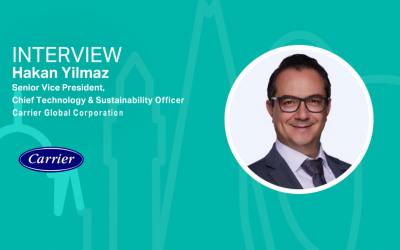Alex Bernhardt on the methods and mechanisms required for net zero alignment
Ahead of the Sustainable Investment Forum North America 2021, Climate Action caught up with Alex Bernhardt of BNP Paribas Asset Management to discuss the methods and mechanisms required for net zero alignment and how the transition to a low carbon economy presents both risks and opportunities.

Ahead of the Sustainable Investment Forum North America 2021, Climate Action caught up with Alex Bernhardt of BNP Paribas Asset Management to discuss the methods and mechanisms required for net zero alignment and how the transition to a low carbon economy presents both risks and opportunities.
What are the major challenges with delivering a net zero investment portfolio?
The biggest challenge facing net zero (NZ) portfolio alignment is the fact that the economy is largely not NZ aligned. This limits the investable universe somewhat substantially for investors looking to align with NZ and emphasizes the importance of forward-looking perspectives and long-term engagement in making investment decisions. To ameliorate this situation investors are increasingly looking for investees to produce science-based carbon emissions targets which are NZ aligned and are promoting this activity via engagement.
How can various stakeholders deliver on net zero and how realistic is it?
There is no question that achieving NZ will be economically disruptive for some industries and in these cases wholesale change to business models may be necessary. It will also be disruptive for the investment industry, which will increasingly need to accommodate new methods of investing which account for the environmental and social impacts of portfolios. The urgency and extent of the climate emergency warrant this disruption and achieving NZ is absolutely realistic – indeed economical versus fossil fuel alternatives – even with existing technologies.
While the transition to a low carbon economy creates a great many risks, it also generates significant opportunities which forward looking investors can capture by investing in existing technologies – e.g. wind and solar projects, developers or manufacturers – or trying to finance new technologies which will accelerate the necessary disruptions – e.g. via clean tech, venture capital or small cap pure play innovators.
What is the actual definition of what a net zero portfolio is and is there a need for standardised definitions?
A NZ portfolio is aligned with a science-based scenario that projects a high likelihood of achieving only 1.5DC of warming by 2050. The challenges with asserting such alignment relate to the difficulties in conducting scenario-based assessment of company and portfolio alignment. These difficulties arise via each of the NZ assessment “building blocks”:
- Company Historical Info: In order to determine corporate alignment with NZ a starting point is the company’s current carbon emissions (or OpEx/CapEx for some models). However, as is well known, disclosure of carbon data is inconsistent and not standardized or required in most jurisdictions.
- Company Projected Info: Per SBTi less than 1,000 companies have committed to science-based targets. This leaves a large swathe of firms where their carbon trajectories need to be inferred.
- Scenario Benchmarks: The climate science community produces dozens (if not hundreds) of climate economy or Integrated Assessment Models (IAMs) which are built to project technological and/or economic scenarios. Among these scenarios many are aligned with a 1.5DC outcome but their projections can vary significantly in granularity, directionality and results. Picking the right scenario (or ensemble of scenarios) has a significant impact on the result of NZ assessment.
Given the above difficulties there is indeed a need for increasing standardization in NZ alignment assessment across the industry. However, designing and organizing around a standard for NZ alignment measurement will take time and effort via collaborative initiatives. This is why we participate in initiatives like the Inevitable Policy Response (IPR) and OS-Climate which are looking to develop a “Realistic Policy Scenario” and an open source Implied Temperature Rise (ITR) measurement methodology respectively. In the meantime asset owners and managers will need to work on approaches to NZ measurement.
Do you think that climate related disclosures should be made mandatory and designed around a core framework like TCFD?
Investors need (indeed crave) additional information to inform climate risk assessment of investees. As an industry, investors continue to struggle with messy carbon data – which is by and large not audited, inconsistently reported and typically missing Scope 3. Requiring disclosure of some of this information would be a boon to ongoing NZ investment efforts, but ideally regulations would go much farther than carbon and include many of the TCFD recommendations and those proffered by other related investor- and corporate-led frameworks.
To this regard, we should not let perfect be the enemy of the good – additional climate or broader ESG-related disclosure requirements are welcomed at this stage. In Europe while SFDR and related regulations are proving complex and difficult to interpret in some respects that the EU Commission is looking to develop such an ambitious sustainable regulatory framework is extremely positive. The effort to comply with these new rules should raise the bar in the investment industry (and eventually among corporations) around ESG data management and disclosure globally, not just in the EU, given the significant interconnectedness of many different regional investment markets.
How do you manage ESG metrics to conduct effective ESG due diligence?
Our proprietary ESG scoring framework produces ESG scores on circa 13,000 issuers of securities following a four-step process. The scores are made available internally to facilitate ESG integration, investment stewardship and more. The four steps are described as follows:
1. ESG metric selection and weighting: To arrive at ESG scores that provide useful insights, we select metrics using three criteria:
- Materiality: We reward companies that score highly on ESG issues that are material to their business, based on the expertise from our Sustainability Centre as well as frameworks such as SASB and empirical studies.
- Measurability and insight: We prefer insightful performance metrics over policies or programmes.
- Data quality and availability: We favour metrics for which data is of reasonable quality and readily available so that we can compare issuers fairly. We use numerous research inputs and data sources (e.g. Sustainalytic, ISS & Trucost) to determine companies ESG scores. The metrics we use are a blend of common and sector-specific.
2. ESG assessment vs. peers: Our assessment is primarily sector-relative, reflecting the fact that ESG risks and opportunities are not always comparable between sectors and regions. For instance, health & safety is less important for an insurance company than a mining company. The 12 000+ companies under coverage are therefore divided into 20 sector groups and 4 geographical areas, leading to 80 ESG scoring peer groups of geographical and sector peers. Each issuer starts with a baseline ‘neutral’ score of 50. We then sum its score for each of the three ESG pillars – Environmental, Social and Governance. An issuer receives a positive score for a pillar if it performs better than the average of its peer group. If it performs below average, it receives a negative score. However, two universal issues that impact all companies are not scored relative to peers, introducing a deliberate ‘tilt’ for the most exposed sectors. These are:
- Carbon emissions: As the world faces an absolute carbon emissions problem, we implement an absolute carbon emission measure, creating a positive bias towards issuers and sectors with lower carbon emissions.
- Controversies: Sectors that are more prone to ESG controversies have slightly lower scores, reflecting increased risk (‘headline’, reputational or financial risk).
The overall result is a quantitative ESG score that ranges from zero to 99, with the ability to see how each ESG pillar has added to or detracted from the company’s final score.
3. Qualitative review: In addition to proprietary quantitative analysis, we also integrate information from third-party sources, our Sustainability Centre’s in-depth research on material issues (e.g. climate change) and our investment teams’ knowledge and interaction with issuers.
4. Final ESG score: combining both qualitative and quantitative inputs, we reach an ESG score ranging from zero to 99, with issuers ranked in deciles against peers. Issuers that are excluded from investment through our Responsible Business Conduct policy are assigned a score of 0. Scores are updated regularly.
Source: Modified from BNP Paribas Asset Management - BNPP AM - Corporate (bnpparibas-am.com)
Alex Bernhardt is speaking at the Sustainable Investment Forum North America during Climate Week NYC, you can join him by registering here today.






